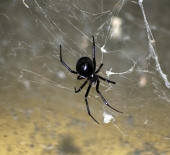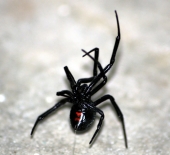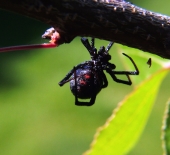The female Black Widow spider has a rounded black body (½ inch) with a red hourglass on the underside of the abdomen. The hourglass can vary from bright to faint red, and the two triangles of the hourglass may not touch. The male Black Widow is smaller, and has shiny black abdomen like the female but lacks the hourglass. Both sexes may have yellow and red marks on their backs in immature stages.
The western Black Widow spider is found almost everywhere in Alameda County. Black Widow spiders are shy, nocturnal, and stay hidden during daylight hours. These spiders rarely reside within the living areas of homes, preferring less trafficked areas with good access to insects. Common sites include garages, attics/basements, burrows, debris, and dense vegetation. They emerge from dark, dry shelters in the evening, making improvements to webbing and waiting for prey.
The female black widow is the most venomous spider in North America. Their venom is 15 times as toxic as the venom of most rattlesnakes. Always seek medical attention if bitten by a Black Widow spider. People are usually bitten because of accidental contact by reaching into a hidden place the spider is located.
- Monitor the corners, ceiling, and door jams for the web sac and vacuum up immediately.
- Avoid leaving your porch light on at night, or use a motion detector sensor. A night-light will attract insects which attract spiders.
- Keep plants back from the perimeter of your living structure. Plants provide food for insects, which are food for spiders. When plants rest against the side of your home, it provides access for spiders to climb into your home.
- A clear open area will reduce the attractiveness to spiders. Remove debris and vegetation that provides shelter for spiders.
- Keep window and door screens in good repair.
- A monthly rinsing of eves, windows, and doors will help reduce spider populations on the exterior of your home.
- An effective way to remove an unwanted spider from your home is to vacuum it up with the hose and wand attachment.
- Locating and removing eggs sacs will reduce future spider populations.
- The use of pesticides can aid in spider control. Use only chemicals registered for spiders. The standard treatment is around windows and doors, under eaves and along the foundation of the home.






